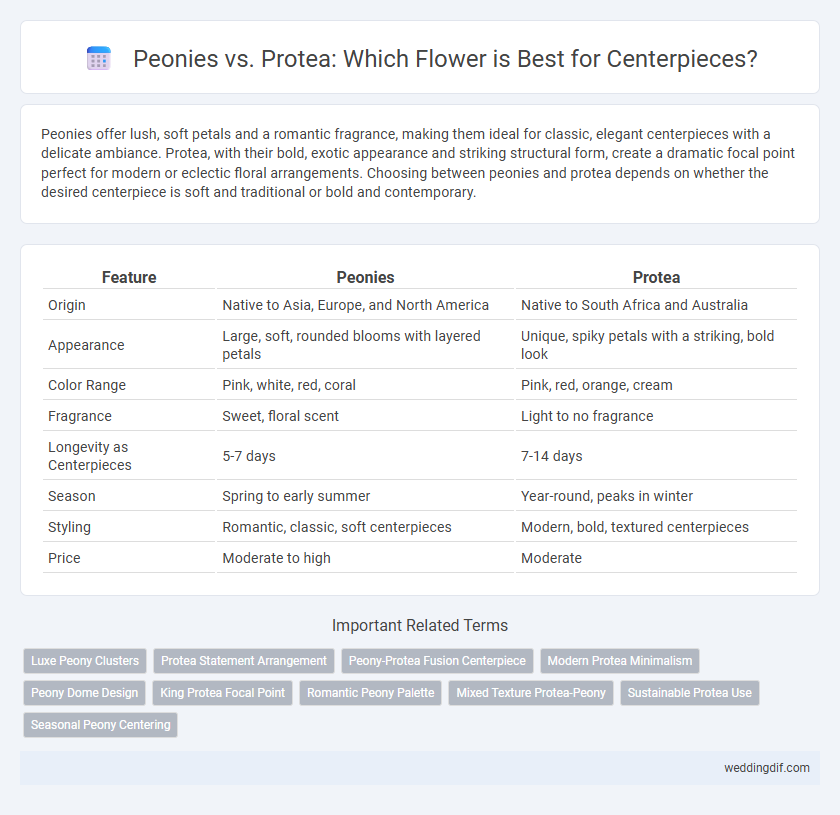Peonies offer lush, soft petals and a romantic fragrance, making them ideal for classic, elegant centerpieces with a delicate ambiance. Protea, with their bold, exotic appearance and striking structural form, create a dramatic focal point perfect for modern or eclectic floral arrangements. Choosing between peonies and protea depends on whether the desired centerpiece is soft and traditional or bold and contemporary.
Table of Comparison
| Feature | Peonies | Protea |
|---|---|---|
| Origin | Native to Asia, Europe, and North America | Native to South Africa and Australia |
| Appearance | Large, soft, rounded blooms with layered petals | Unique, spiky petals with a striking, bold look |
| Color Range | Pink, white, red, coral | Pink, red, orange, cream |
| Fragrance | Sweet, floral scent | Light to no fragrance |
| Longevity as Centerpieces | 5-7 days | 7-14 days |
| Season | Spring to early summer | Year-round, peaks in winter |
| Styling | Romantic, classic, soft centerpieces | Modern, bold, textured centerpieces |
| Price | Moderate to high | Moderate |
Peonies vs Protea: Choosing the Perfect Centerpiece Flower
Peonies offer lush, full blooms with soft petals and a romantic fragrance, making them ideal for elegant, classic centerpieces. Protea provides a striking, exotic look with bold textures and long-lasting durability, perfect for modern or tropical-themed arrangements. Choosing between peonies and protea depends on desired style, color palette, and the event's overall ambiance.
Aesthetic Appeal: Peonies’ Softness vs Protea’s Boldness
Peonies offer a lush, romantic softness with their layered petals and pastel hues, creating an elegant and delicate centerpiece. Protea stands out with its large, spiky blooms and vibrant colors, delivering a striking, bold statement perfect for contemporary or tropical arrangements. The choice between peonies and protea for centerpieces depends on whether the desired aesthetic leans toward gentle refinement or dramatic impact.
Color Palettes: Matching Peonies and Protea to Your Wedding Theme
Peonies exhibit soft, romantic hues such as blush pink, coral, and creamy white, complementing pastel or vintage-themed weddings effortlessly. Protea, with their bold red, pink, and dusty rose tones, create striking focal points ideal for modern or bohemian wedding palettes. Combining peonies and protea offers dynamic color contrasts that enhance both traditional and contemporary wedding decor schemes.
Seasonality: Availability of Peonies and Protea for Weddings
Peonies bloom primarily in late spring to early summer, offering lush, fragrant centerpieces ideal for weddings from April to June. Protea, native to South Africa, flourish year-round but peak availability for floral arrangements is in late winter through early summer, providing unique, exotic options outside the narrow peony season. Selecting between peonies and protea depends on the wedding date, with peonies favored for spring weddings and protea suited for a wider range of seasons due to their extended availability.
Symbolism: Meaning Behind Peonies and Protea in Weddings
Peonies symbolize romance, prosperity, and a happy marriage, making them a popular choice for wedding centerpieces that convey love and good fortune. Protea represents diversity, courage, and transformation, adding a bold and unique touch to wedding decor with its striking appearance. Choosing between peonies and protea depends on whether the couple prefers traditional romantic symbolism or a statement of strength and individuality.
Longevity and Freshness: Which Flower Lasts Longer as a Centerpiece?
Peonies typically last about 5 to 7 days as centerpieces, maintaining their freshness with proper water and cool temperatures. Protea flowers are known for their exceptional longevity, often lasting up to 2 weeks while retaining their structural integrity and vibrant color. Their durability and slower wilting process make Protea a superior choice for longer-lasting floral centerpieces.
Budget Considerations: Cost Comparison of Peonies and Protea
Peonies typically cost more than protea due to their seasonal availability and high demand, often ranging from $5 to $15 per stem. Protea, native to South Africa and available year-round, usually costs between $10 and $20 per stem but can be more affordable when purchased in bulk. Choosing protea for centerpieces can offer a unique, long-lasting alternative that fits better within tighter budgets without sacrificing visual impact.
Design Versatility: Styling Centerpieces with Peonies vs Protea
Peonies offer a soft, romantic appeal with lush, full blooms that complement traditional and elegant centerpiece designs, making them ideal for weddings and classic events. Protea, with their bold, sculptural shapes and exotic appearance, bring a striking modern edge and are perfect for contemporary or tropical-themed arrangements. Both flowers allow versatile styling--peonies blend effortlessly with pastel color schemes and delicate greenery, while protea pairs well with vibrant foliage and minimalist settings to create a dramatic focal point.
Pairings: Complementary Flowers for Peonies and Protea Arrangements
Peonies pair beautifully with complementary flowers like garden roses, ranunculus, and astilbe, enhancing their lush, romantic appeal in centerpieces. Protea arrangements benefit from bold pairings such as eucalyptus, leucadendron, and banksia, which highlight their exotic and sculptural qualities. Choosing complementary florals based on texture and color balance ensures striking and harmonious peony and protea displays.
Expert Florist Tips: Making the Most of Peonies or Protea Centerpieces
Peonies offer lush, full blooms with soft petals ideal for romantic or classic centerpieces, while protea provides a striking, exotic look with their bold shapes and long-lasting durability. Expert florists recommend pairing peonies with greenery like eucalyptus to enhance their delicate texture, whereas protea centers flourish when combined with succulents or native foliage to emphasize their structural form. Selecting seasonal availability ensures freshness--peonies peak in late spring, and protea bloom year-round, making timing essential for optimal centerpiece impact.
Peonies vs Protea for centerpieces Infographic

 weddingdif.com
weddingdif.com